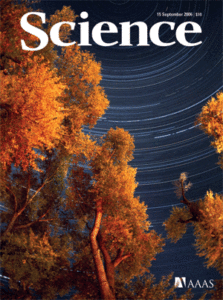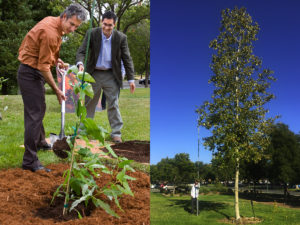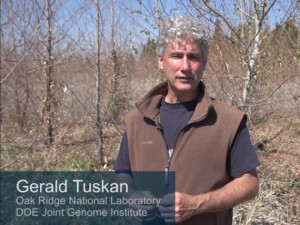
The poplar study on the September 15, 2006 cover of Science.

Then and now: our poplar tree has grown from less than four feet to more than forty feet in 10 years.
When the poplar genome sequence, generated by the DOE Joint Genome Institute, was published in the September 15, 2006 issue of the journal Science, we planted a commemorative sapling on our front lawn that was clonally propagated from the poplar or black cottonwood tree, Populus trichocarpa, whose DNA was used for the study. (Click here to see the DOE JGI’s poplar retrospective on Instagram.)
In a way, the tree’s rapid growth reflects the rise of various genomics technologies that have been harnessed by the research community availing of the poplar genome resources. According to Web of Science, the poplar genome paper has been cited some 1,900 times since its publication, but that’s not the only way to measure its impact.
“The impact of the genome sequence goes way beyond these quantifiable measures because it has fundamentally changed the way that we do science, and opened areas of inquiry that we didn’t even anticipate in the early days,” noted DOE JGI collaborator Steve DiFazio, a poplar researcher at West Virginia University.

Steve DiFazio, West Virginia University
“The genome sequence has allowed researchers to delve into these previously-intractable areas by providing a simplified framework and infrastructure to build inquiries around,” he added. This has allowed people to invest their intellectual and monetary resources into creative and potentially risky research. Prior to the sequencing of the genome, molecular geneticists would typically focus their efforts on a handful of genes that they thought were important for a particular phenotype, usually based on work in Arabidopsis or another model annual plant…. The genome sequence jump-started that process, so people were able to take a discovery-based approach to their research, resulting in the emergence of poplar as a true model organism that is responsible for many novel findings.”
Much has changed in the 10 years since the international consortium selected a tree with a genome of less than a billion bases, not the least of which are the advances in sequencing technologies that have made it possible for sequence much larger and more complex genomes.

ORNL and DOE JGI researcher Jerry Tuskan talked about poplar trees as models for selective adaptation to an environment at http://bit.ly/Tuskan14fingerprints.
“There are now over 1,000 Populus genomes that are resequenced, and have had multiple tissues characterized using RNA-seq, as well as the rich expression data now available through the Gene Atlas project at JGI,” noted Oak Ridge National Laboratory distinguished scientist Jerry Tuskan, one of the senior authors of the 2006 poplar genome paper. Tuskan has spoken about his poplar work at the DOE JGI Genomics of Energy & Environment annual meetings (watch the 2014 talk here and the 2015 talk here). He heads a team studying environmental impacts on poplar plantations along the Pacific Northwest, utilizing the poplar genomes already available and also leads a team at the BioEnergy Science Center (BESC) studying poplar growth and development.
Tuskan added that numerous research projects have received funding from DOE, NSF, and USDA over the past ten years, “due to the availability and quality of the genomics resources created by JGI.” Additionally, he said, the Populus genomic resource “has facilitated research programs in numerous other countries, e.g., China, Sweden, Canada, Spain, Chile, and France.”

Listen here to UBC professor Shawn Mansfield as he reflected briefly on the impact of the poplar reference genome on his own work and on the research community at large.
Shawn Mansfield, professor of Wood Science at the University of British Columbia, also weighed in on the importance of the poplar genome sequence on its 10th anniversary.
“JGI and the rest of the community teamed to put together a reference genome for the first tree. That’s actually now a great example of comparative analysis in other plant species and it was in the tree world. We can glean some very important similarities and differences among industrially important species. It’s a powerful tool; it’s the same kind of power the crop world has, the Arabidopsis [community] has with respect to sequencing all of the different ecotypes, and we never had that before.”
Mansfield’s lab works on lignification – the formation and deposit of lignin in plant cell walls. “Our lab was the first to actually use live cell imaging to visualize secondary cell wall cellulose being biosynthesized,” he noted. Check out his team’s recent Science publication that made use of the poplar reference genome to be able to conduct live imaging of a plant’s secondary cell walls for the first time.